You're here: Main page > 4. History of Eberswalde's trolleybus system > 4.2. Period from May 1945 to 1965
4.2. Period from May 1945 to 1965

In May 1945 was the beginning of the reconstruction of the trolley system under catastrophic conditions. New material could not be procured. Thus the existing predominantly damaged material was repaired and reused.
By the four still existing trolleybuses the trolleybus No. 4I of the German type MPE I became repaired as the first.
Since no batteries were available, for headlights and interior lighting current was taken provisionally out of the
trolley system. The window panes, which were all destroyed, were replaced by
pasteboard and had only a small look through from glass.
The intact sections of the trolley system in Ostend and at the double-tracked branch to the artillery-barracks in direction to Sommerfelde were diminished and reused for the damaged sections of the trolley system between Boldstraße and the Alsen-Platz (today: Karl-Marx-Platz).
On 07 August 1945 after almost 3 monthly repairing of the trolleybus overhead system the resumption of the trolleybus operation took place between Boldstraße and the Alsen-Platz (today: Karl-Marx-Platz) with the only serviceable trolleybus No. 4I of the German type MPE I.
The only trolleybus oscillated between the two end points in two shifts.
The trolleybus No. 1I of the German type MPE I was the second trolleybus, which was putting into operation again after repairing in October 1945.
In January 1946 the resumption of the trolleybus operation took place between Karl-Marx-Platz (former Alsen-Platz) and
Market and a new trolleybus of the German type KEO I (war unit bus standard size 1) no. 2II was putting into traffic. This trolleybus was one of the two trolleybuses, which were sourced out from the Berliner Siemens-Schuckert-plants to Eberswalde toward the end of World War 2. This trolleybus was equipped with a electric motor of the type BBC with 61 kW performance, which originated from a burned out Eberswalde car.
Although there were large problems in the first months after end of the war, the public utilities held up a relatively continuous regular transport service.
In March 1946 the resumption of the trolleybus operation took place between market and Gertraudenstraße.
Also in March 1946 two further trolleybuses of the German type KEO I (war unit bus standard size 1) were fetched from the former company Fahrzeugbau Schumann GmbH Werdau i.Sa. These trolleybuses were first completed and equipped with old parts from burned out Eberswalde cars. They became the car no. 4II and 5II.
These two Eberswalde trolleybuses of the German type KEO I originated from a 12-car-series, which was
originally built for the Austrian trolleybus operation Leoben. By the war events they were split then on the trolleybus operation systems of the Soviet zone of occupation (Greiz, Leipzig, Eberswalde).
Starting from April 1946 were three trolleybuses in the use. At this time the trolleybus no. 4I fell out.
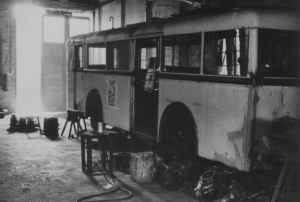 In spite of maintenance problems at the trolleybuses and at the trolley system the trolleybus traffic could be secured to the April 1948. Due to the lack of tires were makeshift driven with full rubber tires. Due to the heavy duty of the trolleybuses and the resultant disadvantages as well as tire and spare part deficiency the trolleybus operation was stopped from April to September 1948.
In spite of maintenance problems at the trolleybuses and at the trolley system the trolleybus traffic could be secured to the April 1948. Due to the lack of tires were makeshift driven with full rubber tires. Due to the heavy duty of the trolleybuses and the resultant disadvantages as well as tire and spare part deficiency the trolleybus operation was stopped from April to September 1948.
After an allocation of tires and spare parts on 25 October 1948 took place the resumption of the trolleybus traffic with only one vehicle.
The public utilities Eberswalde were dissolved to the 01.April 1949 and transferred into the Kommunale
Wirtschaftsunternehmen (KWU) (local business enterprises).
On 11 July 1949 the resumption of the trolleybus operation took place on the single-railed section between Gertraudenstraße and the final stop Ostend. The structure of this section took place using the trolleybus overhead masts of the branch to the artillery barracks. At the turnaround loop Ostend a switch was installed in the trolley system. Thus arose a so-called terminal loop. The former branch to the artillery barracks was not rebuilt again.
One trolleybus commuted on the new section of road in the 20-minutes pulse and 2 trolleybuses protected the line operation from the Gertraudenstraße to the Boldtstraße.
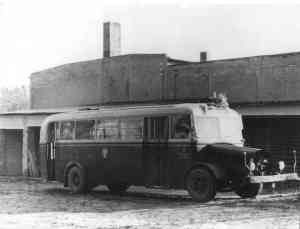 In July 1949 the trolleybus no. 1I of the German type MPE I must be parked too because of missing spare parts.
The car body of this trolleybus was later buoyed on a truck chassis and as motor bus, better known under the name "Jumbo", used.
In July 1949 the trolleybus no. 1I of the German type MPE I must be parked too because of missing spare parts.
The car body of this trolleybus was later buoyed on a truck chassis and as motor bus, better known under the name "Jumbo", used.
Due to the temporary removal from service of the trolleybus no. 1I the sunday traffic was stopped. Since no reserve vehicles were present, upcoming repairs had to be arranged on Sunday.
Through the delivery of missing spare parts took place the initial operation of the second trolleybus of the German type KEO I, no. 3II on 13 February 1950, and so four trolleybuses could be started. Furthermore also the defective trolleybus no. 4I of the German type MPE I could to be repaired. It was taken again in service as trolleybus No. 1II on 27 April 1950. Thus again sunday traffic became possible to the timetable change on 02 June 1950.
Starting from 1950 the German Democratic Republic (GDR) manufactured own trolleybuses in the now state-owned companies
Werdau and Ammendorf of the Lokomotiv-und Waggonbau (LOWA).
With the dissolution of the Kommunale Wirtschaftsunternehmen (KWU) (local business enterprises) on 01 May 1951 the trolleybus enterprise became an independent enterprise and operated now under the name "VEB Verkehrsbetriebe Eberswalde".
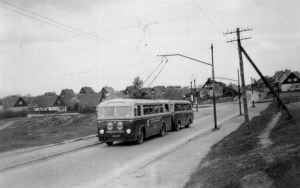 In January 1951 the rolling stock became extended about 3 trolleybuses of the GDR type
LOWA W 600 (no. 6II to no. 8II) and 3 trolleybus trailers of the GDR type LOWA W 700 of the
VEB Waggonbau Werdau.
In January 1951 the rolling stock became extended about 3 trolleybuses of the GDR type
LOWA W 600 (no. 6II to no. 8II) and 3 trolleybus trailers of the GDR type LOWA W 700 of the
VEB Waggonbau Werdau.
Because the trolleybuses of the GDR type LOWA W 600 were supplied with two-bar current collectors and also the
supply of contact heads for the single current collector system BBC of the existing trolleybuses could not be
guaranteed any longer, the change of the trolley system and the trolleybuses took place from the single current
collector system BBC on the two-bar current collector system on one Sunday in Eberswalde in December 1951. For the
backfitting were used current collectors of the existing defective trolleybuses.
In the year 1952 the trolleybus carried already again 4.992.000 persons.
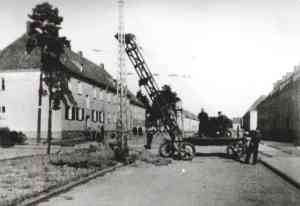 With the re-establishment of the second trolley system trace on the still single-lane distance
Freienwalder Straße/Gertraudenstraße-Ostend the line Westend-Ostend could be driven on continuous from November 1952.
With the re-establishment of the second trolley system trace on the still single-lane distance
Freienwalder Straße/Gertraudenstraße-Ostend the line Westend-Ostend could be driven on continuous from November 1952.
For this reason was the reconstruction of the contact lines of the Eberswalde trolley system essentially finished
and one was able to dedicate himself the necessarily become transport connexion
of the quarter Nordend to the trolleybus network.
On 05 April 1953 the two-lane new building line town center-Nordend became opened. The 3.2 km long trolleybus line
after Nordend branched off at the Friedrich-Ebert-Straße.
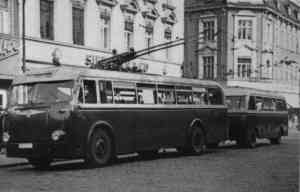 The trolleybus traffic on the line Nordend-Westend will become expanded effective from October 1953 with the initial startup of the trolleybus no. 9II of the GDR type LOWA W 602a and a trailer of the GDR type LOWA W 700 from Sundays on the whole week.
The trolleybus traffic on the line Nordend-Westend will become expanded effective from October 1953 with the initial startup of the trolleybus no. 9II of the GDR type LOWA W 602a and a trailer of the GDR type LOWA W 700 from Sundays on the whole week.
A single ticket cost 0.15 M (M means Mark and the was national currency of the GDR!) at this time. It gave collecting tickets to 10 trips for 1 Mark. The woman conductor cancelled the tickets with a ticket-punch. Starting from 23.00 o'clock applied the overnight rate of 0,20 M for each single ticket. Collecting tickets were then invalid.
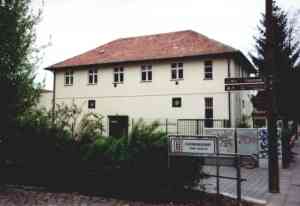 In the same year the electric rectifier station was transferred from the old electric power station to
the new administrative building Bergerstraße.
In the same year the electric rectifier station was transferred from the old electric power station to
the new administrative building Bergerstraße.
On 01 May 1954 an trolleybus of the German type KEO I could be taken after a general overhaul at the company KAFA
Berlin-Schöneweide again in operation. Therewith the situation in the car fleet relaxed. Until 1955 further two
trolleybuses of the German type KEO I were overhauled .
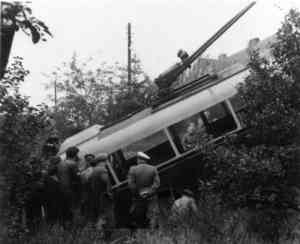 In the year 1955 a heavy traffic accident
occurred with a trolleybus of the German type KEO I (war unit bus standard size 1) on the
line Westend-Nordend in the Poratzstraße.
In the year 1955 a heavy traffic accident
occurred with a trolleybus of the German type KEO I (war unit bus standard size 1) on the
line Westend-Nordend in the Poratzstraße.
For the better distinction of the two trolleybus lines the red-white line sign was introduced in the year 1956, which marks until today the line to Nordend.
In the year 1956 the putting into service of further vehicles took place. The trolleybus No. 4III of the GDR
type LOWA W 602a, manufactured in the VEB Waggonbau Ammendorf, as well as 4 trailers of the GDR type LOWA W 701,
manufactured in the VEB Fahrzeug- und Mähdrescherwerk Weimar came to the use.
In February and March 1956 in the RGW (Council for Mutual Economic Assistance, COMECOM, of the formerly socialist
Eastern Bloc countries) was decided a specialization of the member countries in the vehicle construction. The GDR had the
job to produce small and medium-sized passenger cars as well as trucks until five tons cargo. Within the RGW (Council for
Mutual Economic Assistance, COMECOM) the ČSSR was responsible for the trolleybus production. Thereupon in the year
1956 trolleybus production was totally stopped in the GDR. The GDR received in the future trolleybuses exclusively by
the ŠKODA plants from the ČSSR (today Czech Republic).
The last trolleybus of the German type MPE I was taken out of service in 1957.
In the summer 1958 a new starting distance was finished to the Friedensbrücke. Therewith the divided Straße der
Jugend (Breite Straße) was connected to a street of houses. The trolley system for the trolleybus was mislaid by the
Goethe-Straße into the Straße der Jugend. At the same time at the Platz der Freundschaft a hand-operated
trolley system switch was built into the trolley system.
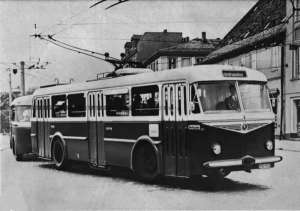 In October 1958 the first two out of the ČSSR imported trolleybuses of the Czech type ŠKODA 8 Tr arrived in Eberswalde. In November 1958 both trolleybuses were used for the first time.
In October 1958 the first two out of the ČSSR imported trolleybuses of the Czech type ŠKODA 8 Tr arrived in Eberswalde. In November 1958 both trolleybuses were used for the first time.
In January 1959 further 3 trolleybuses of the Czech type ŠKODA 8 Tr were supplied. These vehicles were delivered in
more uniform ivory-colored lacquering. Before the use of this virgin trolleybuses they got below the windows a dark green
relacquering. Two of the delivered trolleybuses were designated originally for Berlin. Therefore the trolleybus-trailer
combinations of the GDR type LOWA W 602a with the car no. 4III and 9II were delivered to Berlin to
the Berliner Verkehrsbetriebe (BVG) in exchange for trolleybuses of the Czech type ŠKODA 8 Tr. The trolleybus no.
9II of the GDR type LOWA W 602a was in use until up to the closure of the Berlin trolleybus traffic in the year
1973.
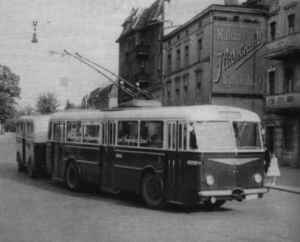 Starting from 22 January 1959 resulted again a substantial breakdown of the trolleybus
traffic in Eberswalde. The railway bridge, the only direct connection between Westend and town center, was closed as
a result of engineering deficiencys for the total vehicle traffic. With it was the only east-west connection of the city
Eberswalde and consequently also the trolleybus lines to Westend interrupted.
Starting from 22 January 1959 resulted again a substantial breakdown of the trolleybus
traffic in Eberswalde. The railway bridge, the only direct connection between Westend and town center, was closed as
a result of engineering deficiencys for the total vehicle traffic. With it was the only east-west connection of the city
Eberswalde and consequently also the trolleybus lines to Westend interrupted.
On 29 September 1960 the in the meantime repaired railway bridge was released again for traffic. For this reason
the interrupted trolleybus traffic to Westend could again continuous resumed.
Through the increasing importance of the new rolling mill in Finow and its further extension existed the necessity of an
improved connection by the public transport (ÖPNV). From 1960 were begun with plannings and preparatory works for an
connection of the city Finow and especially the new rolling mill to the Eberswalde trolleybus network. The connection of
the city Finow and in particular the new rolling mill to the Eberswalde trolleybus network failed however finally because
of the deficiencies of the socialist planned economy. Through a decision of the in the past council of the district
Frankfurt/Oder of the 13. February 1962 the trolleybus project nach Finow was cancelled finally out of the building
program for 1962 and later then not further pursued.
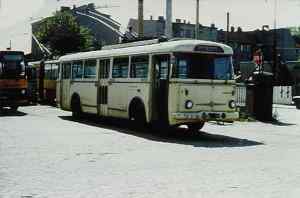 In June 1960 took place the supply of further 2 trolleybuses of the Czech type ŠKODA 8 Tr. These trolleybuses showed
changes in some details.
In June 1960 took place the supply of further 2 trolleybuses of the Czech type ŠKODA 8 Tr. These trolleybuses showed
changes in some details.
In May 1962 were delivered for the first time 5 trolleybuses of the Czech type ŠKODA 9 Tr
to Eberswalde and brought to the use.
The trolleybuses of the Czech types ŠKODA 8 Tr and ŠKODA 9 Tr were not equipped for the operation with trailers.
The corresponding rebuildings for the operation with trailers were accomplished in the maintenance workshops in Eberswalde.
With the use of the trolleybuses of the Czech types ŠKODA 8 Tr and ŠKODA 9 Tr the conditions of employment
improved themselves also for the woman conductors. They could sit now while driving because a cashier seat was beside the
3rd door. The entrance was in the back, the passenger paid and got off then at one of the two front doors.
The vehicle supply in the period 1958 to 1962 made possible the storage or de-activating of all old vehicles. After
conclusion of this process 7 trolleybuses of the Czech type ŠKODA 8 Tr and 5 trolleybuses of
the Czech type ŠKODA 9 Tr were in the rolling stock of the public transportation. The three trolleybuses of the GDR
type LOWA W 600 still served as reserve.
The trolleybuses of the Czech type ŠKODA 9 Tr could not be used with the trailers of the GDR type LOWA W 700. Damages
appeared at the rear axles and later also at the chassis frames.
Thereupon starting from 1962 used trailers of the smaller GDR type W 701 were procured. The production of the trailers of
the GDR type W 701 had been already stopped in 1961 due to an accentuation of the appointments for the use by trailers in
the passenger traffic. For the future an cessation of the use of trailer in the passenger traffic was designated.
In order to be able to secure a speedy passenger dispatching in the regular transport service on 01 November 1962 the view
card system was introduced. At the same time the night drives were stopped.
On 20 February 1965 the VEB Verkehrsbetriebe Eberswalde (Eberswalde bus company) received from the district authority of the German national police Frankfurt/Oder the approval for the realisation of the education of women as trolleybus drivers.

 In spite of maintenance problems at the trolleybuses and at the trolley system the trolleybus traffic could be secured to the April 1948. Due to the lack of tires were makeshift driven with full rubber tires. Due to the heavy duty of the trolleybuses and the resultant disadvantages as well as tire and spare part deficiency the trolleybus operation was stopped from April to September 1948.
In spite of maintenance problems at the trolleybuses and at the trolley system the trolleybus traffic could be secured to the April 1948. Due to the lack of tires were makeshift driven with full rubber tires. Due to the heavy duty of the trolleybuses and the resultant disadvantages as well as tire and spare part deficiency the trolleybus operation was stopped from April to September 1948.
 In July 1949 the trolleybus no. 1I of the German type MPE I must be parked too because of missing spare parts.
The car body of this trolleybus was later buoyed on a truck chassis and as motor bus, better known under the name "Jumbo", used.
In July 1949 the trolleybus no. 1I of the German type MPE I must be parked too because of missing spare parts.
The car body of this trolleybus was later buoyed on a truck chassis and as motor bus, better known under the name "Jumbo", used.
 In January 1951 the rolling stock became extended about 3 trolleybuses of the GDR type
LOWA W 600 (no. 6II to no. 8II) and 3 trolleybus trailers of the GDR type LOWA W 700 of the
VEB Waggonbau Werdau.
In January 1951 the rolling stock became extended about 3 trolleybuses of the GDR type
LOWA W 600 (no. 6II to no. 8II) and 3 trolleybus trailers of the GDR type LOWA W 700 of the
VEB Waggonbau Werdau.
 With the re-establishment of the second trolley system trace on the still single-lane distance
Freienwalder Straße/Gertraudenstraße-Ostend the line Westend-Ostend could be driven on continuous from November 1952.
With the re-establishment of the second trolley system trace on the still single-lane distance
Freienwalder Straße/Gertraudenstraße-Ostend the line Westend-Ostend could be driven on continuous from November 1952.
 The trolleybus traffic on the line Nordend-Westend will become expanded effective from October 1953 with the initial startup of the trolleybus no. 9II of the GDR type LOWA W 602a and a trailer of the GDR type LOWA W 700 from Sundays on the whole week.
The trolleybus traffic on the line Nordend-Westend will become expanded effective from October 1953 with the initial startup of the trolleybus no. 9II of the GDR type LOWA W 602a and a trailer of the GDR type LOWA W 700 from Sundays on the whole week.
 In the same year the electric rectifier station was transferred from the old electric power station to
the new administrative building Bergerstraße.
In the same year the electric rectifier station was transferred from the old electric power station to
the new administrative building Bergerstraße.
 In the year 1955 a heavy traffic accident
occurred with a trolleybus of the German type KEO I (war unit bus standard size 1) on the
line Westend-Nordend in the Poratzstraße.
In the year 1955 a heavy traffic accident
occurred with a trolleybus of the German type KEO I (war unit bus standard size 1) on the
line Westend-Nordend in the Poratzstraße.
 In October 1958 the first two out of the ČSSR imported trolleybuses of the Czech type ŠKODA 8 Tr arrived in Eberswalde. In November 1958 both trolleybuses were used for the first time.
In October 1958 the first two out of the ČSSR imported trolleybuses of the Czech type ŠKODA 8 Tr arrived in Eberswalde. In November 1958 both trolleybuses were used for the first time.
 Starting from 22 January 1959 resulted again a substantial breakdown of the trolleybus
traffic in Eberswalde. The railway bridge, the only direct connection between Westend and town center, was closed as
a result of engineering deficiencys for the total vehicle traffic. With it was the only east-west connection of the city
Eberswalde and consequently also the trolleybus lines to Westend interrupted.
Starting from 22 January 1959 resulted again a substantial breakdown of the trolleybus
traffic in Eberswalde. The railway bridge, the only direct connection between Westend and town center, was closed as
a result of engineering deficiencys for the total vehicle traffic. With it was the only east-west connection of the city
Eberswalde and consequently also the trolleybus lines to Westend interrupted.
 In June 1960 took place the supply of further 2 trolleybuses of the Czech type ŠKODA 8 Tr. These trolleybuses showed
changes in some details.
In June 1960 took place the supply of further 2 trolleybuses of the Czech type ŠKODA 8 Tr. These trolleybuses showed
changes in some details.